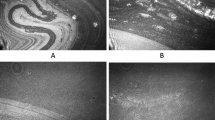Abstract
Infants have been known occasionally to stare without blinking for almost a minute. This puts great demands on the stability of their tear-film. To verify the stability of infant tears, we performed biophysical experiments on Meibomian gland secretion, which forms the outermost layer of the tear-film. The secretion was taken from infants belonging to one of three age-groups (1.5 years, 4–5 years, 7–10 years). Underin vitro conditions we determined the surface pressure and the surface potential of the film by spreading the secretion over a water surface and subsequently compressing and decompressing it. Sufficient amounts of Meibomian gland secretion were expressed in all age-groups. The surface pressure and the surface potential of the tears in infants corresponded to those in healthy adults. It was also found that the younger the patient was, the better was the consistency of the surface potential under repeated periods of compression and expansion. In comparison with the secretion of healthy adults, the infant Meibomian gland secretion showed better biophysical characteristics and a correspondingly higher stability in the tear-film.
Similar content being viewed by others
Abbreviations
- MGS:
-
Meibomian gland secretion
References
Haberich FJ, Lingelbach B. Kritische übersicht über unsere Kenntnisse und Vorstellung einer neuen Arbeitshypothese über die StabilitÄt des prÄkornealen TrÄnenfilms. Klin Mbl Augenheilk 1982; 180: 115–26.
Holly FJ. Formation and rupture of the tear-film. Exp Eye Res 1973; 15: 515–25.
Holly FJ, Lemp MA. Wettability and wetting of corneal epithelium. Exp Eye Res 1971; 11: 239–50.
Kaercher T, Möbius D. StabilitÄt und FlexibilitÄt der Lipidschicht des TrÄnenfilms sowie deren pathologische VerÄnderungen im biophysikalischen. Experiment Fortschr Ophthalmol 1989; 86: 245–8.
Kaercher T, Möbius D. Biophysical characterisation of the Meibomian gland secretion under in vitro conditions. Int Ophthal 1992; 16: 167–76.
Kuhn H, Möbius D, Bûcher H. Spectroscopy of monolayer assemblies. In: Weissberger A, Rossiter B (eds) Physical methods of chemistry. New York: Wiley and Sons, 1972; 3B: 577–702.
Liotet S. Nouvelle théorie sur la stabilité du film lacrymal et son application en pathologie. Bull Soc Opht France 1987; 6–7: 751–4.
Penbharkkul S, Karelitz S. Lacrimation of the neonatal and early infancy period of premature and full-term infants. J Pediatr 1962; 61: 859–63.
Ruckenstein E, Sharma A. A surface chemical explanation of tear film breakup and its implications. In: Holly FJ (ed) The preocular tear film in health, disease and contact lens wear. Lubbock; 1986: 697–727.
Sjögren H. The lacrimal secretion in newborn premature and fully developed children. Acta Ophthal 1955; 33: 557–60.
Tiffany JM. The lipid secretion of Meibomian glands. Adv Lipid Res 1987; 22: 1–63.
Vogel V, Möbius D. Local surface potentials and electric dipole moments of lipid monolayers: contributions of the water/lipid and the lipid/air interfaces. J Coll Interface Sc 1988; 126: 408–20.
Author information
Authors and Affiliations
Rights and permissions
About this article
Cite this article
Kaercher, T., Möbius, D. & Welt, R. Biophysical behaviour of the infant Meibomian lipid layer. Int Ophthalmol 18, 15–19 (1994). https://doi.org/10.1007/BF00919408
Received:
Accepted:
Issue Date:
DOI: https://doi.org/10.1007/BF00919408




